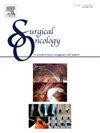骨骼肌和内脏脂肪密度是胰腺腺癌患者总生存率的预测性成像生物标志物:一项回顾性多中心分析
IF 2.4
4区 医学
Q3 ONCOLOGY
引用次数: 0
摘要
原理和目的利用PDAC分期计算机断层扫描(CT)成像的全自动人工智能生成的身体成分分析(BCA)来发现总体生存(OS)的预测性成像生物标志物。材料与方法回顾性收集4个三级中心的PDAC常规分期ct(2012年7月- 2020年12月)和临床病理资料(东部肿瘤合作组(ECOG)表现情况、切除情况、化疗情况、年龄、CA19-9、Charlson合并症指数、BMI)。采用3:1分割(训练:不训练),我们使用骨骼肌指数(SMI)、总肌室面积和密度(TMC)、骨骼肌(SM)、皮下脂肪组织(SAT)、内脏脂肪组织(VAT)等7个临床病理和9个BCA变量的每种可能组合来拟合Cox回归OS,并选择具有最低信息复杂性(ICOMP)的组合。通过比较BCA模型与基础模型(不含BCA变量)计算BCA的附加值。结果纳入472例PDAC患者,其中女性213例,平均年龄67.9±11.5岁,可切除170例,不可切除106例,转移196例。选取4个临床病理指标(ECOG、切除情况、化疗、CA19-9)和5个BCA指标(SMI、SM密度、VAT密度、TMC面积、VAT面积)。SM密度降低(肌骨化病)和VAT密度增加与OS有很强的相关性(p分别为0.0094和0.0019)。与基础模型相比,BCA模型在所有亚组中表现出更好的表现(AUC:可切除0.76比0.70,不可切除0.76比0.69,转移性0.80比0.75)。结论:bca识别出的肌骨化病和VAT密度增加是所有PDAC亚组OS的预测性成像生物标志物,可能增加前期风险分层的价值。本文章由计算机程序翻译,如有差异,请以英文原文为准。
Skeletal muscle and visceral fat density are predictive imaging biomarkers for overall survival in patients with pancreatic adenocarcinoma: A retrospective multicenter analysis
Rationale and objectives
Utilizing a fully automated AI-generated body composition analysis (BCA) from PDAC staging computed tomography (CT) imaging to discover predictive imaging biomarkers for overall survival (OS).
Material and methods
Routine PDAC staging CTs (07/2012–12/2020) and clinicopathological data (Eastern Cooperative Oncology Group (ECOG) performance status, resection status, chemotherapy, age, CA19–9, Charlson Comorbidity Index, BMI) from four tertiary centers were collected retrospectively. Using a 3:1 split (training:holdout), we fitted Cox regression OS using every possible combination of 7 clinicopathological and 9 BCA variables: skeletal muscle index (SMI), area and density of total muscle compartment (TMC), skeletal muscle (SM), subcutaneous adipose tissue (SAT), visceral adipose tissue (VAT) and selected the combination with the lowest information complexity (ICOMP). The added value of BCA was calculated by comparing the BCA model with the base model (without BCA variables).
Results
Analysis included 472 PDAC patients (213 female, mean age 67.9 ± 11.5 years, resectable n = 170, unresectable n = 106, metastatic n = 196). Four clinicopathological (ECOG, resection status, chemotherapy, CA19–9) and 5 BCA variables (SMI, SM density, VAT density, TMC area, VAT area) were selected. Decreased SM density (myosteatosis) and increased VAT density showed strong association with OS (p = 0.0094 and 0.0019, respectively). The BCA model showed superior performance compared to the base model in all subgroups (AUC: resectable 0.76 versus 0.70, unresectable 0.76 versus 0.69, and metastatic 0.80 versus 0.75).
Conclusion
BCA-identified myosteatosis and increased VAT density to be predictive imaging biomarkers for OS in all PDAC subgroups, potentially adding value to upfront risk stratification.
求助全文
通过发布文献求助,成功后即可免费获取论文全文。
去求助
来源期刊

Surgical Oncology-Oxford
医学-外科
CiteScore
4.50
自引率
0.00%
发文量
169
审稿时长
38 days
期刊介绍:
Surgical Oncology is a peer reviewed journal publishing review articles that contribute to the advancement of knowledge in surgical oncology and related fields of interest. Articles represent a spectrum of current technology in oncology research as well as those concerning clinical trials, surgical technique, methods of investigation and patient evaluation. Surgical Oncology publishes comprehensive Reviews that examine individual topics in considerable detail, in addition to editorials and commentaries which focus on selected papers. The journal also publishes special issues which explore topics of interest to surgical oncologists in great detail - outlining recent advancements and providing readers with the most up to date information.
 求助内容:
求助内容: 应助结果提醒方式:
应助结果提醒方式:


